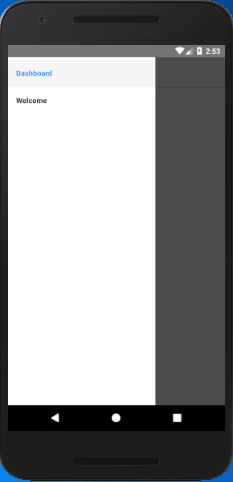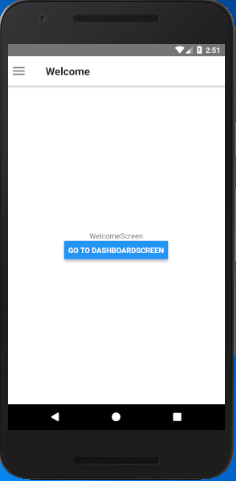React Native Tutorial
- React Native Tutorial
- React Native Environment Setups
- React Native First Application Hello World
- React Native View
- React Native State
- React Native Props
- React Native Style
- React Native Height and Width
- React Native Button
- React Native Layout and Flexbox
- React Native Positioning Element with Flex
- React Native ScrollView
- React Native ListView
- React Native FlatList
- React Native SectionList
- React Native Touchables
- React Native Text Input
- React Native ActivityIndicator
- React Native Picker
- React Native StatusBar
- React Native Switch
- React Native WebView
- React Native ProgressBarAndroid
- React Native ProgressBar With Animated
Navigation
- React Native Navigation
- React Native Configuring Header Bar
- React Native Moving Between Screens
- React Native Passing Value between Screen
- React Native Tab Navigation
- React Native Adding Icons at the Bottom of Tab Navigation
- React Native Create Material Bottom Tab Navigator
- React Native Top Tab Navigator
- React Native Drawer Navigation
Storage
React Misc
- React Native Google Map
- React Native Modal
- React Native Vector Icons
- React Native Splash Screen
- React Native vs. Ionic
- React Native vs. Xamarin
- React Native vs Flutter
- React Native vs React
- React Native vs Swift
- Box shadow in React Native
- React Native IAP
- React-Native Localization
- React Native Toast
- React Native Sound
React Native Drawer Navigation
React Native Drawer Navigation is an UI panel which displays the app's navigation menu. By default it is hidden when not in use, but it appears when user swipes a finger from the edge of the screen or when user touches at the top of drawer icon added at app bar.
React Native Drawer Navigation imports the createDrawerNavigator from the react-navigation library.
It implements the createDrawerNavigator() to add the list of classes (screens).
To open and close the drawer, use the following helper methods:
this.props.navigation.closeDrawer();
If you like to toggle your drawer then call the following method:
Each of the above methods openDrawer(), closeDrawer(), and toggleDrawer() are simply dispatching actions as:
this.props.navigation.dispatch(DrawerActions.closeDrawer());
this.props.navigation.dispatch(DrawerActions.toggleDrawer());
Before creating the React Native drawer navigation, first go through the React Native Navigation where we discussed the react-navigation installation process.
React Native Drawer Navigation Example
Create two separate classes "DashboardScreen" and "WelcomeScreen" in the react native app to display on screen. Add these screens to createStackNavigator and add "md-menu" icon of 'react-native-vector-icons/Ionicons' package. On pressing the menu icon, call navigation.openDrawer() method to open drawer.
Now, import createDrawerNavigator from 'react-navigation' package and implement createDrawerNavigator(). After that add the stack navigation screen over it.
import { View, Text, StyleSheet, Button } from 'react-native';
import Icon from 'react-native-vector-icons/Ionicons';
import {
createSwitchNavigator,
createAppContainer,
createDrawerNavigator,
createStackNavigator
} from 'react-navigation';
export default class App extends Component {
render() {
return <AppContainer />;
}
}
class WelcomeScreen extends Component {
static navigationOptions = {
title: 'Welcome',
};
render() {
return (
<View style={{ flex: 1, alignItems: 'center', justifyContent: 'center' }}>
<Text>WelcomeScreen</Text>
<Button
title="Go to DashboardScreen"
onPress={() => this.props.navigation.navigate('Dashboard')}
/>
</View>
);
}
}
class DashboardScreen extends Component {
static navigationOptions = {
title: 'Dashboard',
};
render() {
return (
<View style={{ flex: 1, alignItems: 'center', justifyContent: 'center' }}>
<Text>DashboardScreen</Text>
</View>
);
}
}
const DashboardStackNavigator = createStackNavigator(
{
DashboardNavigator: DashboardScreen
},
{
defaultNavigationOptions: ({ navigation }) => {
return {
headerLeft: (
<Icon
style={{ paddingLeft: 10 }}
onPress={() => navigation.openDrawer()}
name="md-menu"
size={30}
/>
)
};
}
}
);
const WelcomeStackNavigator = createStackNavigator(
{
WelcomeNavigator: WelcomeScreen
},
{
defaultNavigationOptions: ({ navigation }) => {
return {
headerLeft: (
<Icon
style={{ paddingLeft: 10 }}
onPress={() => navigation.openDrawer()}
name="md-menu"
size={30}
/>
)
};
}
}
);
const AppDrawerNavigator = createDrawerNavigator({
Dashboard: {
screen: DashboardStackNavigator
},
Welcome: {
screen: WelcomeStackNavigator
},
});
const AppSwitchNavigator = createSwitchNavigator({
Dashboard: { screen: AppDrawerNavigator },
Welcome: { screen: WelcomeScreen },
});
const AppContainer = createAppContainer(AppSwitchNavigator);
const styles = StyleSheet.create({
container: {
flex: 1,
alignItems: 'center',
justifyContent: 'center'
}
});
Output:





